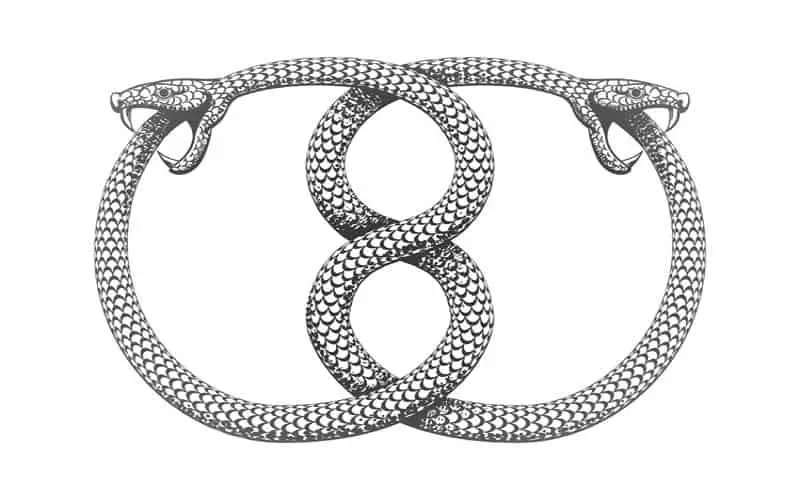Throughout human history the serpent has been captivating minds as an ever-present symbol with complex meaning across cultures.
Why?
Serpent symbolism appears across cultures from dragons in China, to tales of Greek Gods, to the fall of man in the book of Genesis.
And just as varying as its presence in these traditions is its role, meaning, and symbolism. The serpent takes on different meanings ranging from the seducer of death, to the awakener of divine consciousness, and a lot in-between.
In this article we’ll explore the roles the serpent plays in various traditions around the world to get a better understanding of the meaning this iconic symbol plays in human existence.
Let’s Dive In.
What is a Serpent: The Origin
Snakes vs. Dragons vs. Serpents
Serpents:
Most of the time when we hear the term “serpent” we tend to veer toward the negative. Serpents give us ”bad vibes” and we tend to think of an evil villain in a story (or a slimy lawyer).
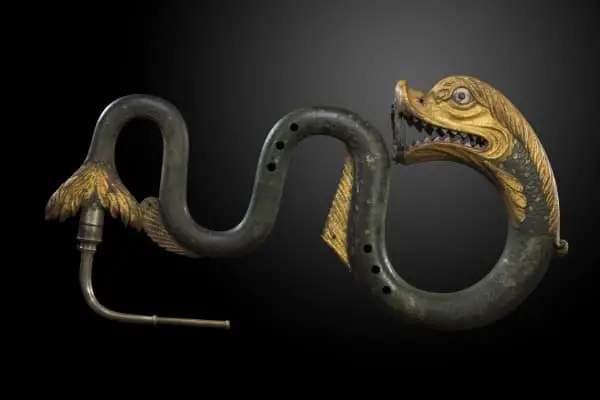
The word serpent (and the word serpentine) comes from the ancient Greek word “Serpens”. In ancient Greece “Serpens” was the name of a snake shaped constellation in the stars.
As the story goes in Greek mythology Serpens is a snake held by the god of medicine, Asclepius.
Defining “serpent” today is not an exact science.
Websters Dictionary, Oxford Dictionary, and Collins Dictionary all have slightly different definitions of “serpent”.
All agree that a “serpent” is a general term for a snake-like creature usually (but not always) associated with negative, creepy, and seductive qualities.
The term serpent is more often used in traditional and mythological stories, being perceived as almost a mystical creature and generally not a very nice one. Modern-day it is rare to hear the term “serpent” used outside of a story.
Dragons:
A dragon is a solely mythical creature that can often breathe fire and has the ability to fly.
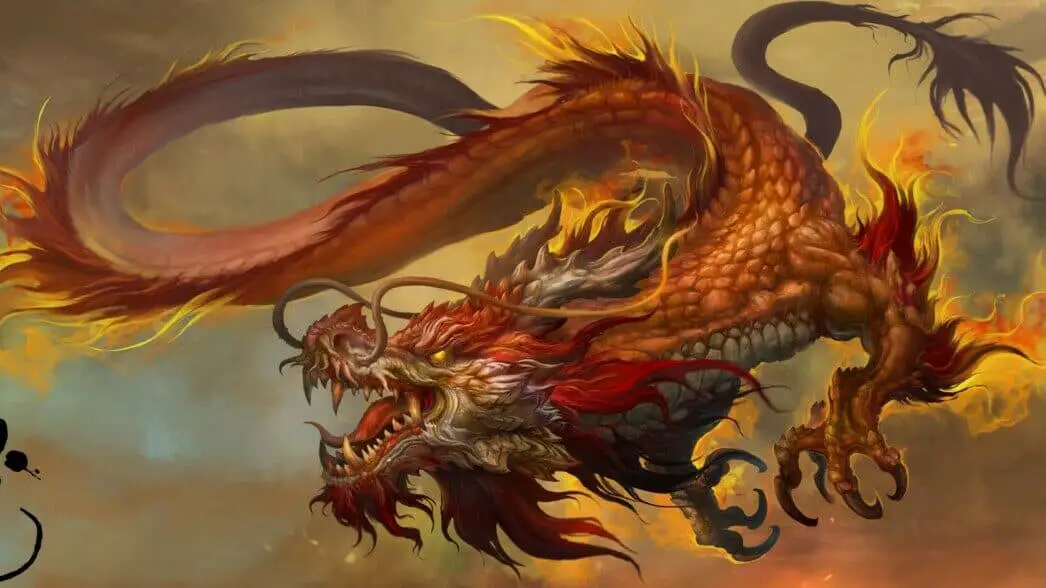
While most traditions do portray them with legs and arms, there are some images that show them with no limbs. The dragon’s reputation can also be a bit of a mixed bag, as it can use its fire-breathing ability for good or evil.
According to the American Natural History Museum within many European traditions, the dragon is seen as the bringer of chaos, an evil creature while in many Asian cultures, it is seen as a symbol of good luck and fertility.
The Chinese zodiac lauds the Year of the Dragon as one of the more fortunate years to be born.In both cultures dragons are purely symbolic.
Snakes:
A snake is of the Reptilia suborder of Serpentes but clearly more defined than literary serpents and mythological dragons.
Modern day snakes are generally associated with more positive qualities as compared to a ‘serpent’.
Serpent Symbolism: What Do Snakes (and serpents) Represent?
Serpents have a rich variety of metaphorical meanings and history
Positive Snake Symbolism:
While the snake archetype often gets a bad rep, there are many cultures and traditions that revere it as a positive symbol. Here are a few that do.
Fertility, Rebirth, Resurrection
Snakes are often seen as a symbol of fertility, both in the physical and financial realms.
According to the History Network, cultures in Greece, Egypt, and indigenous North America hold the snake in high esteem as a symbol of fertility, rebirth, resurrection, and immortality.
A prime example of this concept is ‘’the ouroboros symbol’’ of the snake eating its own tail. The image represents the never ending universe, resurrection, death not being the end of life, and time being a continuous loop. This symbol can even be found in the tomb of King Tut himself.
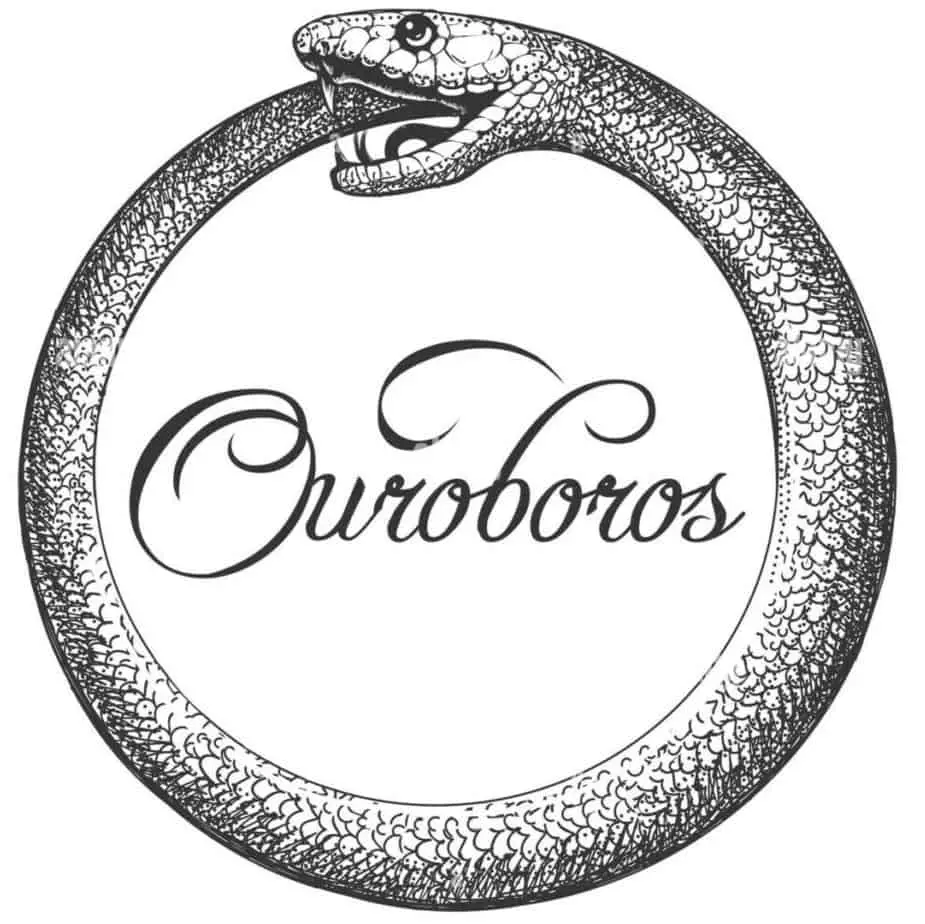
Another example comes from the Hopi Native American tribe of Arizona. The Hopi tribe have ritually performed a “snake dance” for 1000’s of years to encourage rainfall and fertility of their land.
The dancers perform a multi-day ritual which even includes putting live snakes in their mouths and dancing with them around their necks.
According to the Theodore Roosevelt Center, part of the ceremony was observed by the former president. An actual video of what the president witnessed can be found on their website.
Protection
In the Buddhist religion snakes have been seen as protectors, as their large teeth and powerful bite make them the perfect guardians.
In fact, in Buddhist, Hindu, and Jain traditions the Naga, which is the Sanskrit word for serpent, took a half-human, a half-snake form in order to guard the Buddha himself, his teachings, the Dharma.
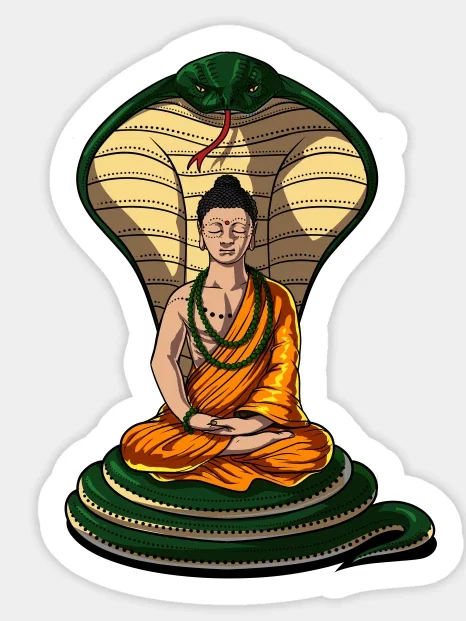
The naga king, Mucalinda, was said to protect the Buddha from a storm by spreading his cobra-like hood over the Enlightened One. A statue depicting the event is kept in the Bangkok museum in Thailand.
If you’re thinking the name “Naga” sounds vaguely familiar to you, something similar pops up in J.K. Rowling’s well-known Harry Potter books. It is close to the name of Lord Voldemort’s beloved pet and protector, his snake “Nagini.”
While the “dark lord” isn’t exactly a warm and fuzzy character, his snake is his loyal guardian, portraying how once again, a serpent’s skills can be used as a protective force.
Healing and Medicine
The caduceus symbol, also known as the “Staff of Hermes”, can be found all over our modern-day world today. This is the symbol of healing we see in medical facilities, hospitals, and ambulances.
Not to be confused with the “Staff of Hermes”, the “Rod of Asclepius” is a different snake symbol showing a singular straight rod with one snake entwining it.
The “Staff of Hermes” and “Rod of Asclepius” are commonly mistaken for one another and are both internationally recognized symbols of healing.
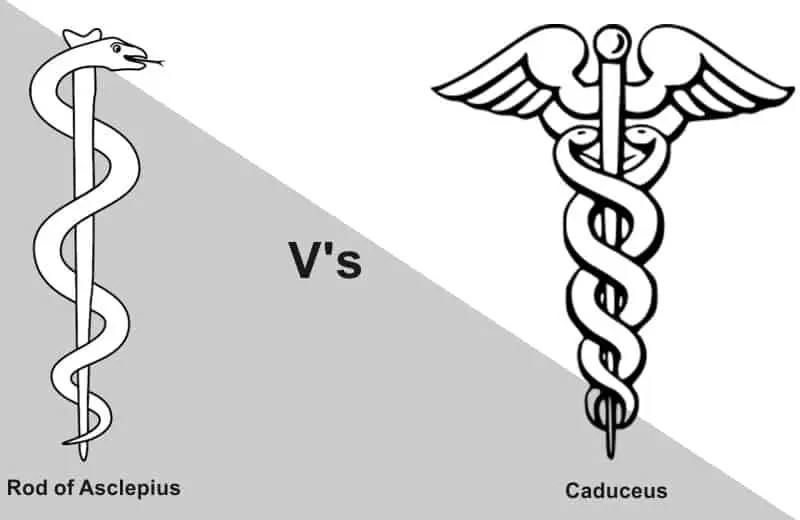
The original origin of the caduceus symbol is unknown, but some suggest the caduceus originates in Mesopotamia with the Sumerian snake god Ningishzida.
Ningishzda’s symbol is a staff with two snakes intertwined around it, dating back 4,000 BC to 3,000 BC.
Wisdom/ Enlightenment
As written by psychiatrist and philosopher Dr. Neel Burton, the serpent can also be seen as a symbol of great wisdom as it is a common image associated with Greek “seers” or ‘’future observers’’.
The ‘’seers’’ of ancient Greece believed they had the ability to receive divine messages from the universe and make predictions about the future. They often connected with gods and goddess’s directly and received and translated messages from them to the people.
Snakes are viewed as having a connection with the subconscious and the ethereal and because of that Greek mythology often uses them as a symbol of wisdom and “seers”/oracles.
The Greeks weren’t the only ones who made that association, in fact, they may have borrowed it from the Egyptians who symbolized the oracle of the water goddess Wadjet, as a snake. She was also sometimes depicted as a woman with the body of a snake.
In Hinduism, the word “Kundalini” literally means “coiled snake,”. As noted in YogaJournal Kundalini is an energy body said to sit at the base of the spine, ready to be released. This is directly connected to the deep understanding of the chakra system.
Once the snake uncoils and moves up the body towards the top of the head, then enlightenment and pure bliss is thought to be achieved.

The snake energetic body can be released through forms of yoga, mantra, meditation, and breathing exercises. In this tradition, the snake is a very positive symbol of achieving enlightenment and ultimate wisdom.
Duality: Balance and Harmony
The serpent symbol can have very positive or negative attributes that it can use towards ends of good or evil.
It is no great leap to view the snake as a symbol of duality, balance, and harmony within the individual and the collective consciousness of society.
Dr. Neel Burton also points out that the venom of the snake itself can represent an antidote or a poison, depending on its usage.
Therefore, the symbol of the twisting snakes we so often see, especially in the medicinal caduceus can also replicate this concept of duality and harnessing both natures inherent in humanity, medicine, and the subconscious.
The concept reflects that the twisting nature of the serpents symbolizes the constant battle that goes on between good and evil. Also that it can be combined to accommodate the good and negative forces, in order to create balance and harmony within oneself and the collective.
Negative Serpent Symbolism:
Now we get to the dark underbelly(pun intended) of the serpent image. Here are a few ways and places our friend the snake doesn’t get painted in the best possible light.
The Underworld
The fact the snake crawls on the Earth is thought to be a symbol in many traditions of its close ties to the underworld, that it is more of “the below” as opposed to a bird who flies in the sky being closer to “the above” in a heaven/hell, under/upper worlds paradigm.
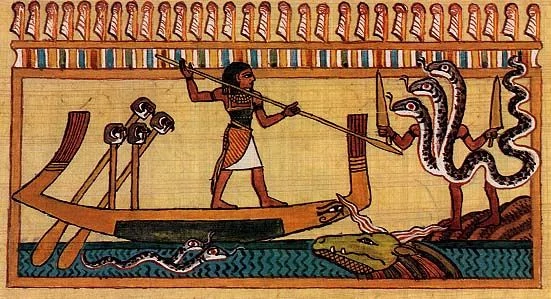
It doesn’t get much worse than being seen as the creature responsible for the entire fall of man. However, the serpent is labeled in the Old Testament as the dark trickster that did exactly that. In the book of Genesis, of the Old Testament the serpent convinces Eve to eat the forbidden apple, claiming “when you eat from it your eyes will be opened, and you will be like God, knowing good and evil.”
According to the story, Eve does so and the rest is, shall we say history.
The History Network dives more into the symbolism of the twisted tale, elaborating that because of the snake’s deceit, the Biblical God punished the snake to “crawl on your belly and you will eat dust all the days of your life.” The debate as to whether the serpent represented is an actual snake or simply an allegory for human or sexual desire wages on to this day.
Many scholars feel symbols of snakes are symbols and are meant to stand for fault, sin, the underworld.
Venom / Poison:
Snakes are not cute and cuddly like you cat, they come well equipped with dagger sharp fangs and often poisonous venom. This connection between venom and poison is why many cultures associate serpents with the concept either literally or symbolically of a poison.
When someone we know is spreading rumors, gossip, or just general negativity, what is a common phrasing we use? We find ourselves saying things like they are “spreading their poison” or “spewing venom”.
Snake venom is one of the few components on Earth that works as its own poison and antidote. The National Library of Medicine traces the use of venom as medicine all the way back to the ancient Mediterraneans according to archeological and literary data.
Death:
Not only are snakes often thought to be tied to the underworld, but they are also often symbolized as an ambassador to it, by bringing death. For example, cleopatra was thought to have killed herself with the purposeful bite from a snake.
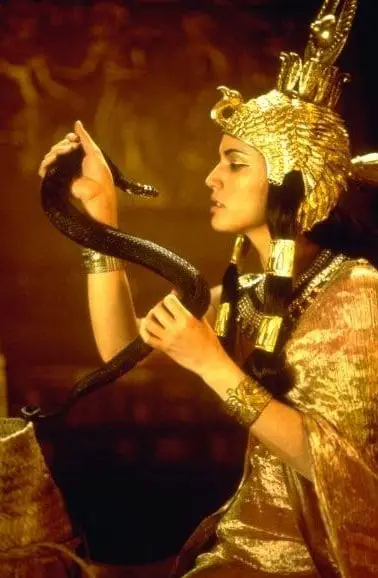
Due to their very powerful venom, some snakes can bring death to a person within a matter of minutes. It’s no wonder serpents get a reputation as an ambassador to the underworld.
In fact, in many snake-handling traditions, in which religious practitioners handle live and venomous snakes the ritual is viewed as an exercise in proving their triumph over death and their ultimate faith..
Snake hypnotizers are viewed in a similar light, as people who are able to master the power of death, implying the snake itself is a symbol of death.
Stealth:
Another very common symbol of the snake is stealth. Snakes are incredibly powerful hunters, gliding silently over the ground, sneaking up on their prey, and striking with incredible speed.
Serpents hunt by surprise creating almost no warning signs as they persue prey.
The concept of serpent stealth also shows up a lot in contemporary and classical literature. LiteraryDevices dives into several works of poetry that utilize the snake in all its symbolic glory, most especially in the realm of stealth.
Why Are Serpents so Captivating Throughout Time
Throughout the ages serpents have captured both humanity’s imagination and its sense of fear.
Snake can represent death and if there’s anything humans are fascinated with its death. Some are scared of death while other enjoy defying death while staring it in the face.

Ophidiophobia, the Greek world meaning “The Fear of Snakes.”
As Psychology Today authors point out, the fear of snakes is often something present from childhood, as opposed to other phobias which develop later in life. It seems that this fear is almost ingrained in us.
As noted by National Geographic, when babies are shown pictures of snakes they consistently react with larger pupils as compared to pictures of flowers and fish.
So whether the snake appears as our friend or foe, it is clearly that the snake archetype is way deep down in our psyche.
Final Thoughts: Symbolism of Serpents
The snake may have played many roles over time, but one thing it has consistently been, is present.
Whether it is a symbol of protection or deception, the serpent symbol is one that has been around as long as humanity itself.
Check Out Our Other Interesting Articles About Symbolism
- The Flower of Life: Symbolism, Meaning & Origin Explored
- The Lotus Flower Meaning | Symbolism & History
- Archangel Metatron’s Cube: History, Origin & Symbolism
- The Namaste Symbol | Om Symbol Meaning | Yoga Symbols
- Tree of Life Symbol: Meaning & Origin
- The Meaning Behind The Freemason Symbol: History & Origin
- The Dharma Wheel Meaning: Origin Explained
- The Ankh (unk) Symbol: Ancient Egyptian Meaning
- Elephant Symbolism & Meaning Explained
- Scarab Beetle Symbolic Meaning | History & Origin
- Symbolism, Meaning, and Origin of The Serpent
- What Are Sacred Geometry Symbols & Meanings
- What Is The Egyptian Eye Of Ra ? Symbolism Explained
- The Eye of Horus vs. The Eye of Ra | Meaning
- What’s Your Third Eye? How To Open It ?
Loved what you read?
Hit that share button and let the world in on the secret – we’d be thrilled!
Got thoughts? We’re all ears for your feedback, corrections, or a good old chat. Don’t be shy; drop us a line.
And hey, don’t miss out on our curated list of must-reads in the recommended books section.
Big thanks for diving in with us today!


